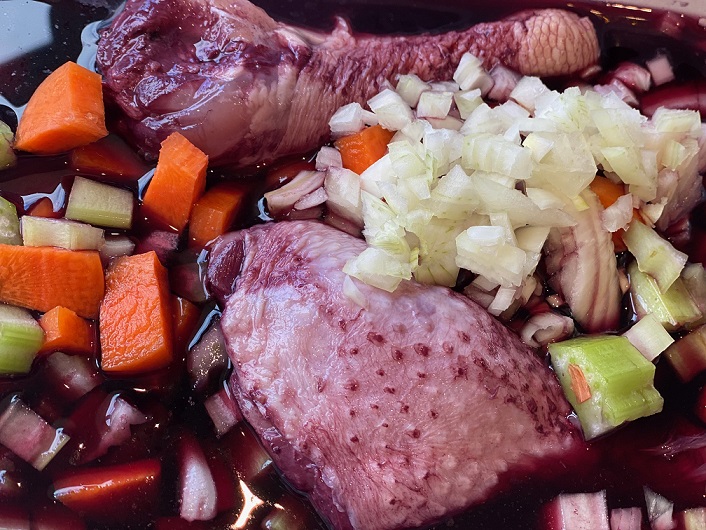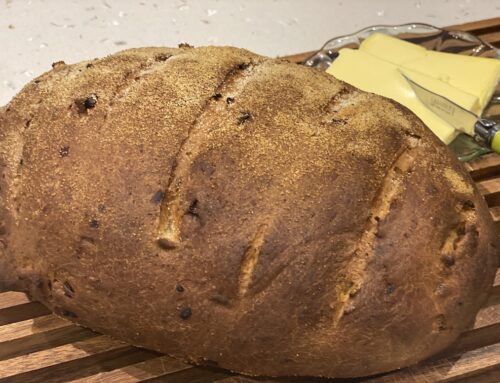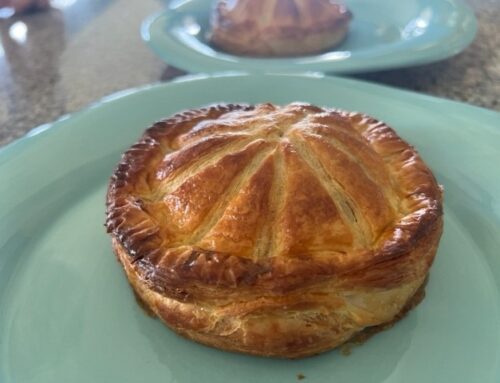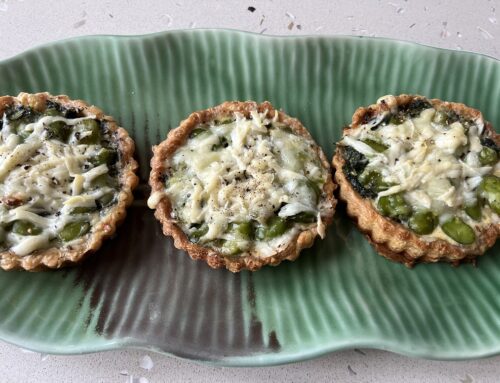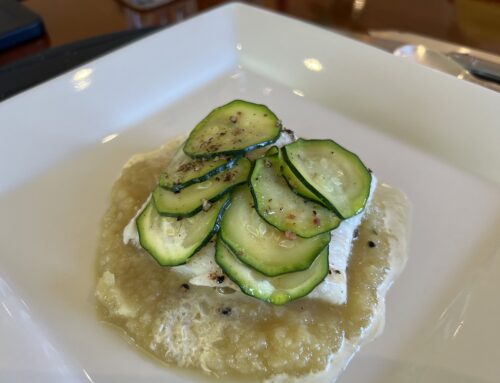This is a flavoursome classic Burgundian dish, with red wine playing a major role in the flavour, along with lardons, button mushrooms and tiny onions. The flavour of this dish, like many others, improves when the dish is refrigerated and served the next day. It is traditionally cooked on the stove-top, however, you can also cook it in the oven at 175℃.
In France, on our Betty B barge, I frequently cooked a simple coq au vin as it was easy to manage in my small barge kitchen, the ingredients readily available and it can be made ahead the day before and reheated. In France they have the very best and most flavourful lardons which I loved to use, plus the tiny onions, I used eschallots, were inexpensive and plentiful. The button mushrooms were always in the markets and the fresh herbs I often grew onboard. You will find my simplified Betty B Barge coq au vin recipe on the website as well as the classic version here.
Serves 6 – 8
For the marinade
1 onion, finely diced
2 garlic cloves, crushed with the blade of your chef’s knife
1 carrot, finely diced
1 celery stick, finely diced
6 peppercorns
1 bottle red wine such as a Côte de Rhône or Australian shiraz
30 ml olive oil
Chicken
One chicken leg and thigh cutlet with skin on, per person
20 pearl or pickling onions or 10 shallots, peeled
Bouquet garni, an aromatic bundle of fresh herbs
3 – 4 sprigs fresh thyme
2 stalks celery
6 fresh parsley sprigs
3 fresh bay leaves
20g butter
20ml olive oil
200g smoked speck, or good quality bacon, cut into strips
Butter
Olive oil
500g button mushrooms, kept whole, unless too big, wiped well with paper towel
Butter and olive oil for the chicken
250ml brandy
500ml beef stock
Sea salt and pepper
Extra chopped fresh parsley for garnish
To prepare the chicken: when you bring your chicken home from the market, remove from the plastic wrapping, wipe it dry with paper towels and remove any stray offal inside the thigh. Sprinkle with a little sea salt inside and out and store in a plastic container until you are ready to marinate it.
To make the marinade: finely chop and dice the onions, garlic, carrot and celery and put them in a pot with the peppercorns and red wine. Bring to a simmer for 5 minutes and allow to cool completely. Put the chicken into a large bowl or wide and shallow dish, and when the marinade is cold, pour it over the chicken, pour the olive oil over the top, cover with cling wrap and place in the refrigerator for 12 hours or so, turning the pieces occasionally.
To make the wine reduction: remove the chicken pieces from the marinade, pat them very dry with paper towel, sprinkle with some sea salt and freshly cracked pepper, and set aside until you are ready to cook them. It is best to have the chicken at room temperature for the cooking, and so it is fine to leave them out for up to 2 hours, unless it is a hot day. Pour the wine and vegetables into a large wide pan, bring slowly to the boil and simmer until reduced by half, to about 375mls. Strain the marinade through a sieve over a bowl and reserve both the wine and the vegetables.
For the garnish: an easy method for peeling the pickling onions, is to loosen their skins, by putting them in a bowl, cover with boiling water and leave for a couple of minutes. Remove the onions and the skins are easily slipped off. Simmer the peeled, whole onions in salted water until just softened; drain and set aside for pan-frying later.
Prepare the bouquet garni: a bouquet garni is an aromatic bundle of fresh herbs, used to flavour dishes and then it is removed and discarded at serving time. Make it with a couple of the celery sticks cut into 6cm lengths, a few sprigs of thyme, parsley and the bay leaves; tie with string or wrap them in a muslin bag and tie securely; if using a muslin bag, add about 6 or so black peppercorns as well.
For the speck: dice the speck or bacon. Heat the butter and olive oil in the casserole dish or frying pan, and when sizzling, add the speck and cook until crisp. Remove from the pan and set aside, ready to be added to the sauce at the end along with the mushrooms.
To cook the mushrooms: before cooking the mushrooms, wipe them clean and dry well with a paper towel. The mushrooms need to be dry; the butter needs to be sizzling and the pan should not be over-crowded. If the pan juices from the speck cooking are not enough, add a little butter and olive oil to the pan. When sizzling, cook the mushrooms in small batches without overcrowding the pan. Toss and shake the pan for 3 – 4 minutes. During their sauté, the mushrooms at first absorb the fat; after 2 – 3 minutes the fat will reappear on their surface and the mushrooms will brown. If you sauté too many at once, they steam rather than fry; their juices escape, they stew and they do not brown. The small batches is essential. Successfully sautéed mushrooms should be golden browned with none of their moisture exuded during their cooking.
For the chicken: if necessary, add a little more olive oil and butter to the pan, return the pan to the heat, and when sizzling, cook the chicken pieces, a few at a time. This is for the same as the mushroom cooking. You do not want to over-crowd the pan; the heat in the pan must be retained to obtain a lovely golden skin. Cook skin side down until nicely golden, about 10 minutes. Turn the chicken pieces over and brown the other side. Turn the chicken back over. Heat the brandy in a small pot, set it alight and pour it, flaming, over the chicken. Shake the pan until the flames die down. Remove and repeat until all the chicken is cooked and flambéed. Any brandy left in your jug, add to the dish. Set aside.
Add a 20g knob or so of butter, plus 20ml olive oil to the casserole and when sizzling, add the reserved vegetables from the marinade and sauté gently until softened. Add the chicken pieces, pour in the reserved marinating liquid and the stock. Nestle the bouquet garni into the centre of the casserole, bring it back to the simmer and continue at the lazy bubble, cooking over low heat until the pieces are just tender when pierced with the 2-pronged fork, about 35-45 minutes. When cooked, transfer the chicken to a dish and keep warm. Remove the bouquet garni and discard.
Wipe out the casserole, add another 20g butter and 20ml of olive oil, add the tiny pickling or eschallot onions and toss until golden. Remove and set aside.
Strain the sauce through the chinois over the onions, pressing down on the vegetables with the ladle to extract the maximum flavour and liquid.
Return all the chicken pieces to the casserole dish with the onions, speck and mushrooms to heat through.
Stir in the butter. Adjust seasoning.
Garnish with parsley and serve with steamed green beans and broccoli or a fresh green salad.
*Beurre Manié meaning, kneaded butter. This is one of the best ways to thicken a sauce or a soup, plus it makes it beautifully glossy. Simply mix equal parts of softened butter and flour together in a small bowl; use your fingers or a fork to form it a smooth paste and roll it into a walnut-sized ball. To thicken the sauce, bring it to a simmer, and whisk in one ball of beurre manié at a time until the sauce is smooth and you have the consistency you require.
About the Coq au Vin
The Burgundian Coq au Vin and Boeuf Bourguignon share many similarities. They are both regional Burgundian specialities, and they showcase the famous Burgundian wines, Bresse chickens and Charolais beef. Their method of cookery is very similar as well. When this dish is cooked with one of these Burgundian wines it takes the name of the name of the wine used in the cooking, such as Coq au Chambertin. It seems like a pity to use a Chambertin; so I usually use a Côte de Rhône or an Australian shiraz; if making it with white wine and chicken stock I use a Chardonnay or Riesling and then it is called Coq au Riesling.
The coq au vin is regarded as an ‘elevation of the traditional and simple chicken and wine ragout’, when, with the addition of the lardons, the garnish of small braised onions and sautéed button mushrooms, it becomes well suited for ‘fine company’. When preparing this dish for ‘fine company’ you may like to thicken the sauce, just before serving, with the a classic beurre manié* which will give the sauce a nice gloss as well.
Classic famous dishes such as this one, have various versions appearing in almost all of the classic French cookbooks. Some are more complicated and require more time to cook, however, when a few steps are removed, the dish can be quite simple.
In France, on our Betty B barge, I frequently cooked a simple coq au vin as it was easy to manage in my small barge kitchen, the ingredients readily available and it can be made ahead the day before and reheated. In France they have the very best and most flavourful lardons which I loved to use, plus the tiny onions, I used eschallots, were inexpensive and plentiful. The button mushrooms were always in the markets and the fresh herbs I often grew onboard. You will find my Betty B Barge coq au vin recipe on the website as well as the classic version here.
Elizabeth David, forever the purist, and a revered and honoured English cookery writer, and the infamous Julia Child, have given us their very comprehensive recipes and ones I like very much. Thankfully, Elizabeth does suggest that the tradition of thickening the sauce with the blood of the chicken is not necessary to make this a genuine coq au vin! Interestingly neither do not marinate the chicken the night before. Elizabeth does muse over her dilemma of getting the sauce to the right consistency without spoiling the bird by overcooking it. So, she suggests two alternatives. One is to cook the bird whole, and while carving it, reduce the sauce until it thickens or the second option is to half prepare and reduce the sauce first; then cook the bird in portions, in the reduced sauce. For this method, you need to be careful to have enough liquid for the cooking of the chicken, otherwise it may be too dry. Elizabeth David and Julia Child both liked the cognac flambé as does Anne Willan and Richard Olney, and it definitely adds some theatre in cooking class!
Anne Willan, cookbook author and founder of the famous La Varenne Cooking School in Paris and Burgundy, explains that in the country kitchens of regional France, the old cockerels were used in such dishes as this and therefore it needed both the marinade and the slow cooking to tenderise and flavour the ‘coq’. James Martin and his food hero, Keith Floyd, both use a marinade. This is not necessary to do today, as the chickens we use are tender and young, so the marinating step is often omitted. I never marinated the chicken on the barge. Here I am choosing to marinate my chicken in the classical manner for additional flavour.
Richard Olney, referred to above, is a famous American food writer, who lived for the last 30 years of his life in Provence, who was a contemporary and friend of Julia Child and Elizabeth David,
and author of The French Menu Cookbook, voted one of the best of all time by an Observer Food Monthly panel, observes when writing about the coq au vin ‘it is only logical that a bird no more than 2 months old, though perfect for a sauté … should be less satisfactory in a dish whose qualities depend on the flavour and gelatinous material which, over an extended period, may be drawn from the meat into a reduced and concentrated sauce.’ As a compromise, he suggests using leg and thigh pieces, which lend themselves much better to this type of preparation than do whole birds and breasts, and replacing half the wine with a ‘rich gelatinous veal stock’, and I always love the addition of a good stock.
You will find countless recipes for the coq au vin, made in the traditional manner with red wine and beef stock and the coq au vin blanc, or coq au Riesling when white wine is used along with chicken stock and sometimes cream.
- Mise en place
- Red wine and vegetable marinade
- Chicken sizling in little butter and olive oil
- Coq au Vin ready for the table




